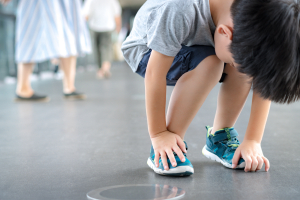Proprioception comes from the Latin word proprius which means individual and caprio which means to take or to grasp. The proprioceptive system, housed deep in our ligaments and joints, operates silently in the background of everything we do. It helps us interpret the weight of our limbs and direction of movement so we can recognize where our bodies are and anticipate where our bodies are going. This sixth sense helps us develop motor control and posture. It helps us judge how much space we take up and how to move through space.
As adults, when someone asks us where our toes are, we already know without looking. If you ask young children the same question, they will reach down and touch their toes because they are still sorting out the mental map of their bodies which is driven by the powerful proprioceptive sense. The act of touching their toes helps them lay down that mapping.

Proprioceptive System
Generally speaking, the proprioceptive system should be fully developed by age 7. A child who has a well-developed proprioceptive system moves with confidence, can hold his body up, has strong posture, and moves without bumping into things or people. He has well-defined personal space, as well as the ability to sit still and attend to a task because his proprioceptive sense knows what his body parts are doing.
A child who has poor proprioception may crave proprioceptive input. He may satisfy this craving by jumping, bumping, or crashing into things. He may love heavy pressure on his body, like a tight bear hug. Or, he may struggle knowing where his body is in relation to other objects or people, appearing clumsy and bumping into things or people. These children have difficulty recognizing how much force to use, so they may tag or hit too hard or even break pencil lead when writing.
Lack of The Proprioceptive System
Other children with poorly developed proprioception may have the opposite reaction and may avoid proprioceptive input. They may be overly cautious in their play, dislike tight clothing or may overreact to the slightest touch.
Regardless of how it manifests, when the proprioceptive sense isn’t working properly, everyday tasks become difficult. When we don’t know where our hands and arms are in space, simple tasks like putting on shoes, buttoning a shirt, or holding a pencil become challenging. Climbing or playing with fluidity can be difficult because we don’t know where our feet and legs are and what they are doing. And, friendships can be hard to build when we continually use too much force or are constantly invading our classmates’ personal space.
What is Proprioceptive Sense?
The proprioceptive sense makes the body and brain aware of posture, movement, and resistance based on the body’s position. When we don’t know where our bodies are in space, or the amount of space they take up, it is hard to control our bodies when it is time to sit still. So, a poorly developed proprioceptive system makes attending, focus, and concentration hard to master.
Sadly, many of these wigglers will be seen by adults as misbehaving or may even be diagnosed with ADD or ADHD. But they are simply trying to stretch, extend, and contract their muscles and joints to understand their place in the world. They are not misbehaving – they are geolocating!
What can you do to help children develop this critical system? Heavy work, heavy play, heavy chores! For children who avoid proprioceptive input, construction of that mental map is still necessary but will come a little harder. Give them lots of opportunities to take little steps towards heavy work and reassure them with their efforts, allowing them to stop when it is too much so they can try again at another time.
Proprioceptive Input Activities
Give children ample opportunity to move their bodies in big ways. Here are some ideas:
- Climb a tree
- Build a fort
- Play in an obstacle course
- Have a pillow fight
- Run up a slide
- Carry anything heavy including a pile of books, a bucket of water or sand, grocery bags
- Play catch with a bean bag
- Pull a wagon or a sled filled with heavy thing
- Rake the leaves
- Dig in the garden
- Take out the trash
The bottom line is that strengthening the proprioceptive sense happens with movement. It is movement that sends information deep into the joints and ligaments, building that essential body map.
Looking for ideas for some activities to strengthen the proprioceptive sense? Check out these activities:






Leave A Comment